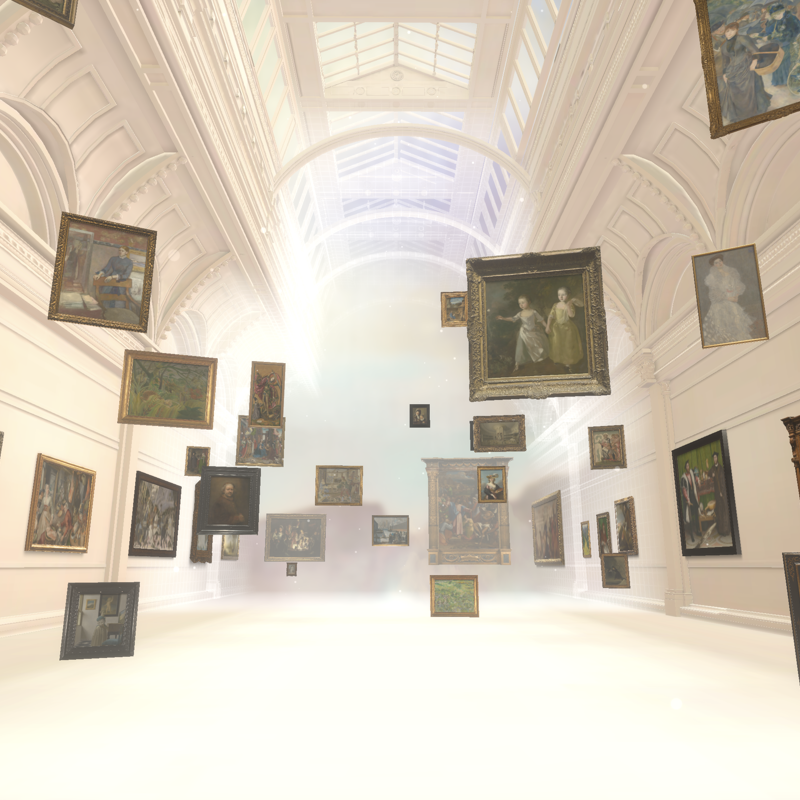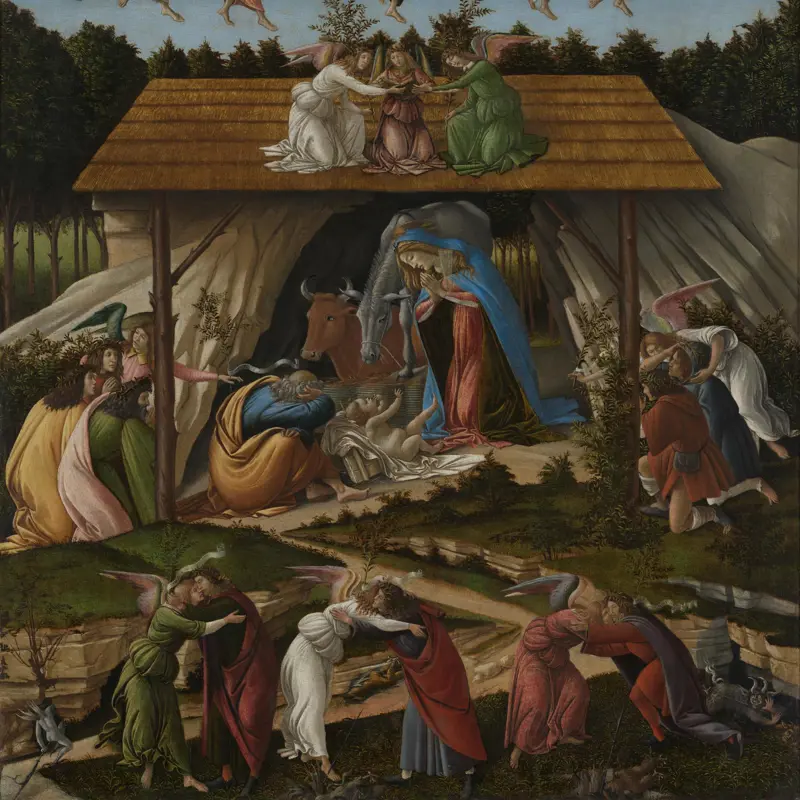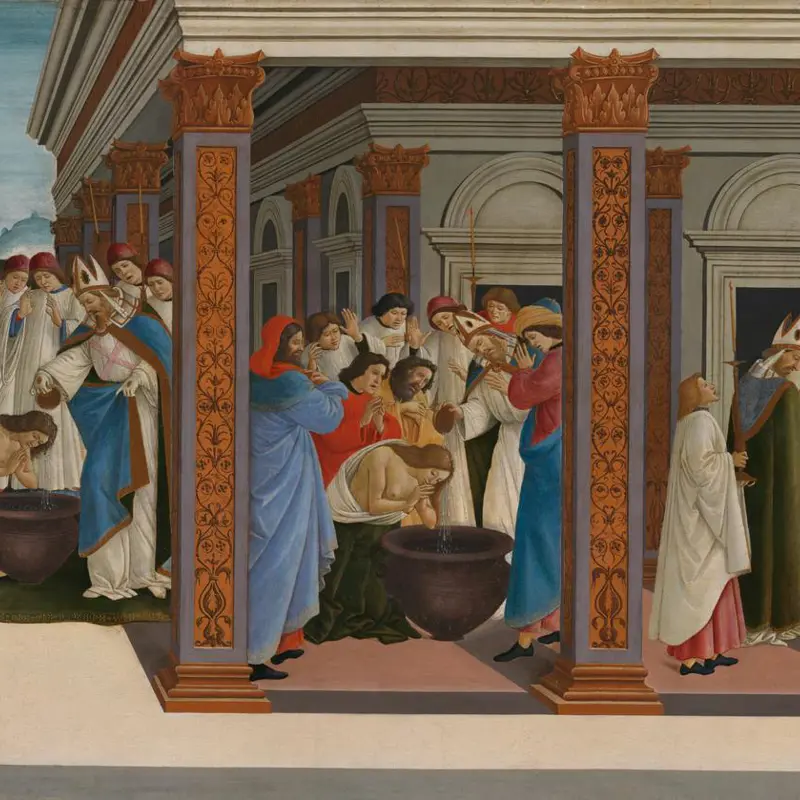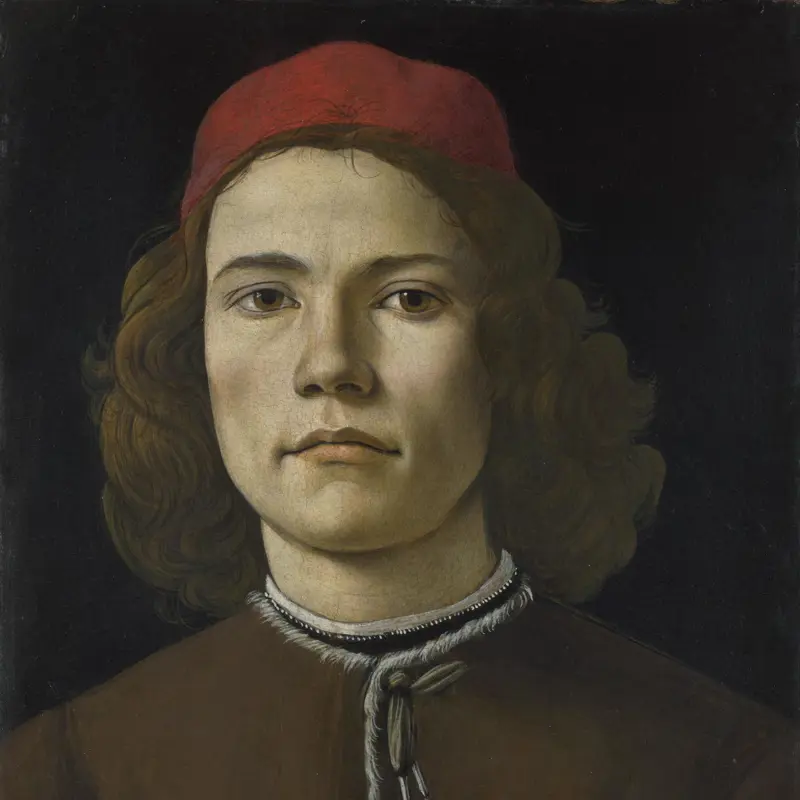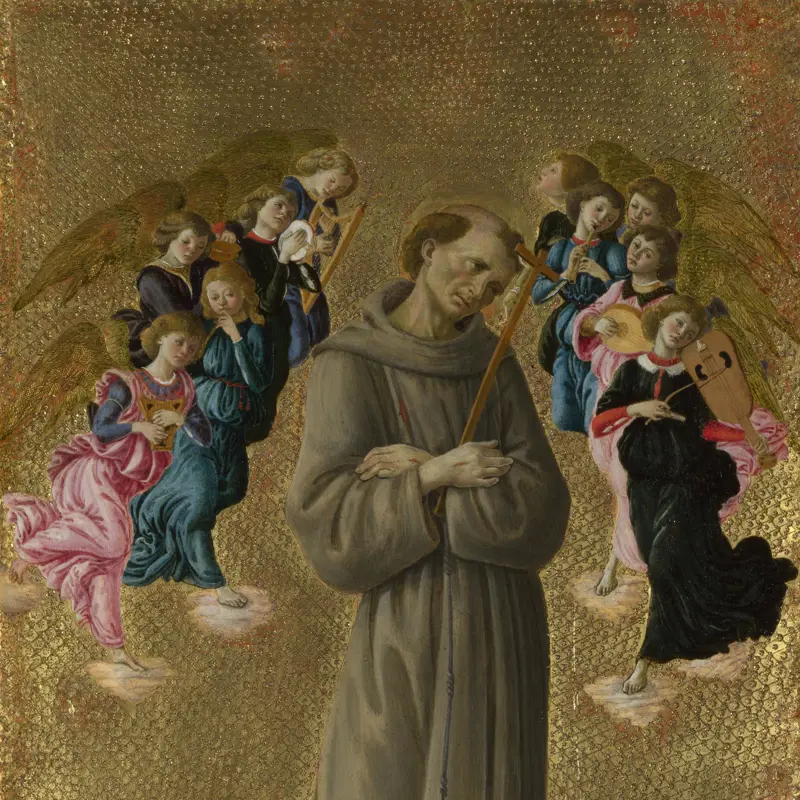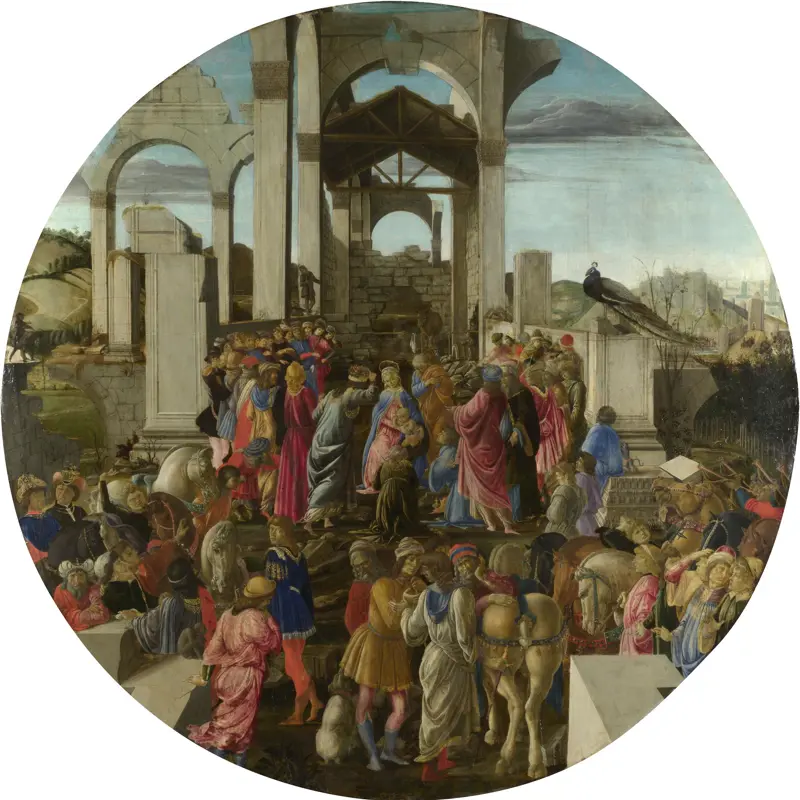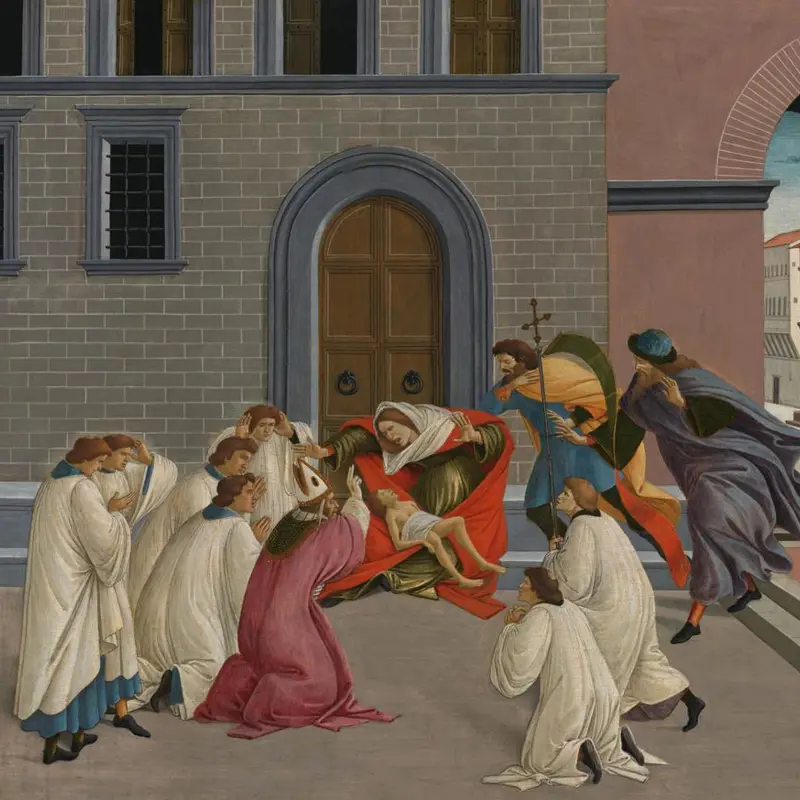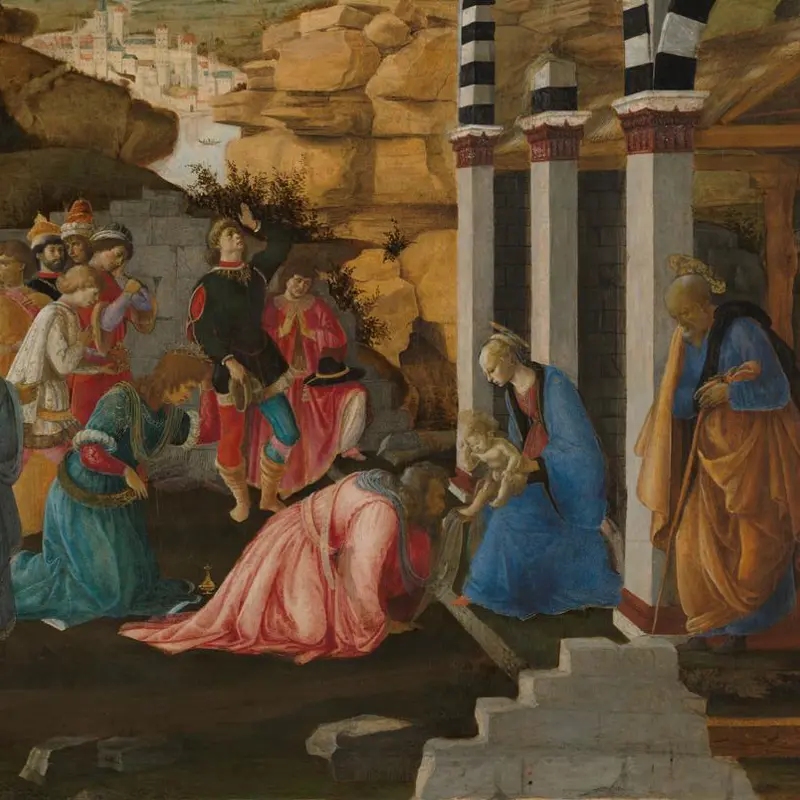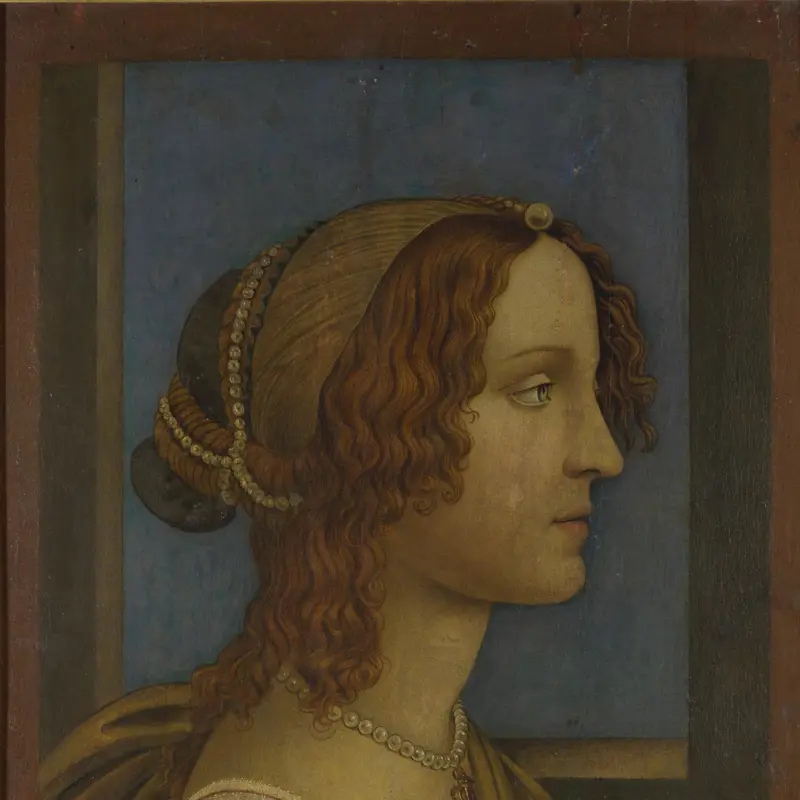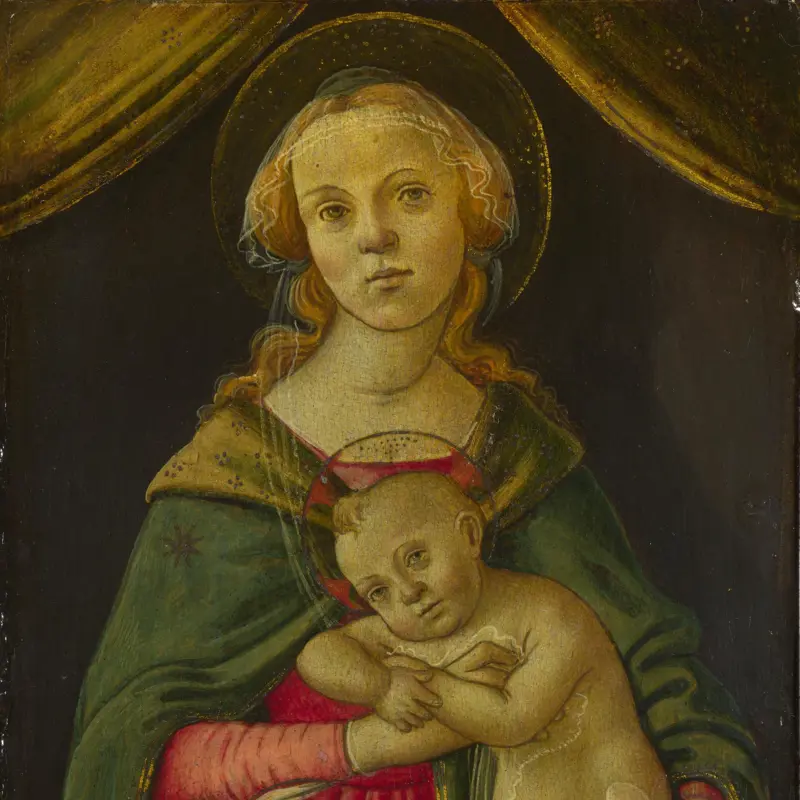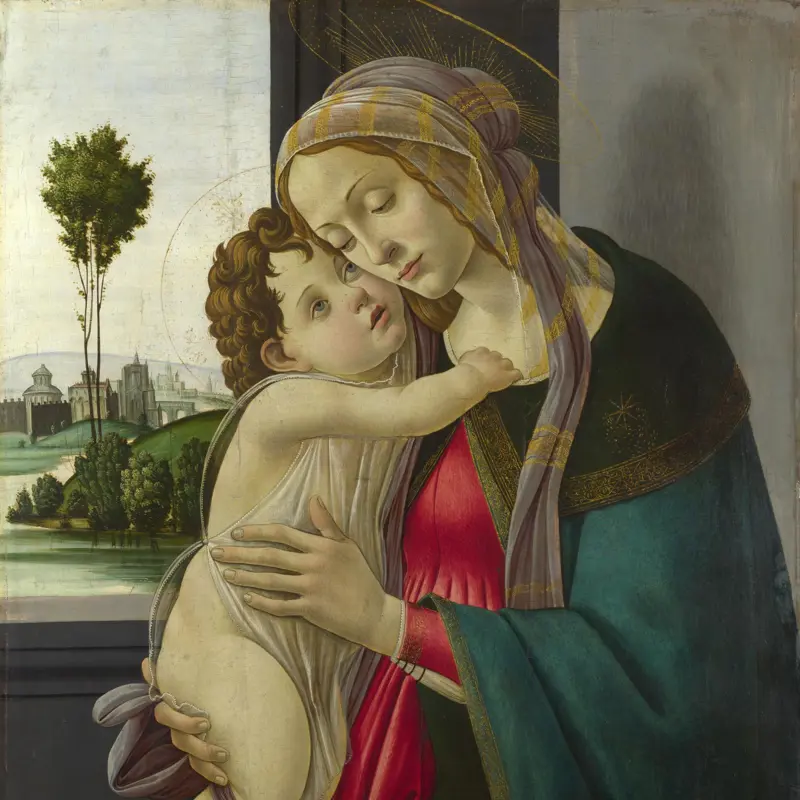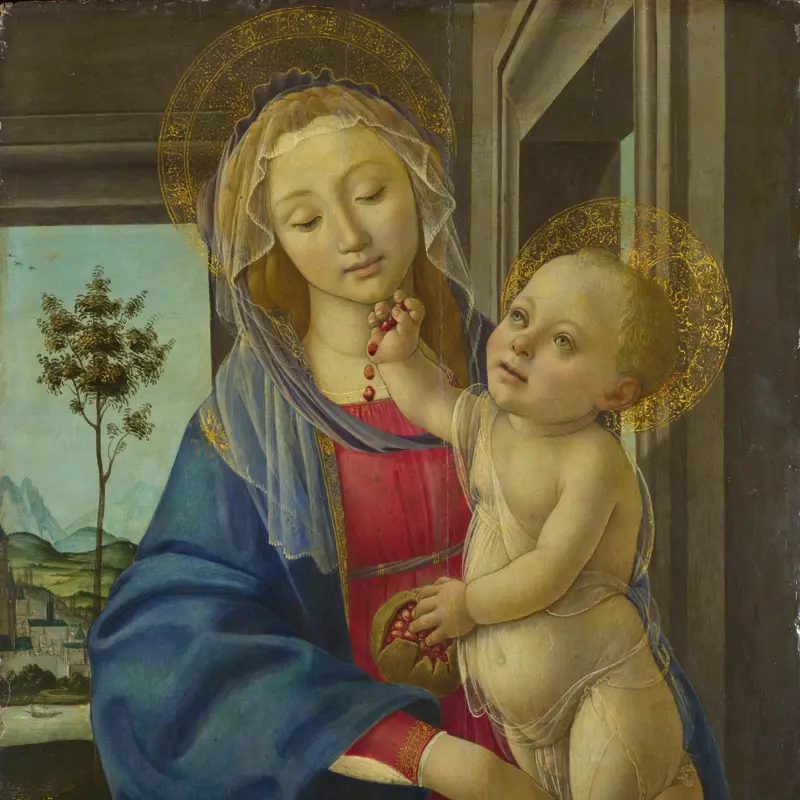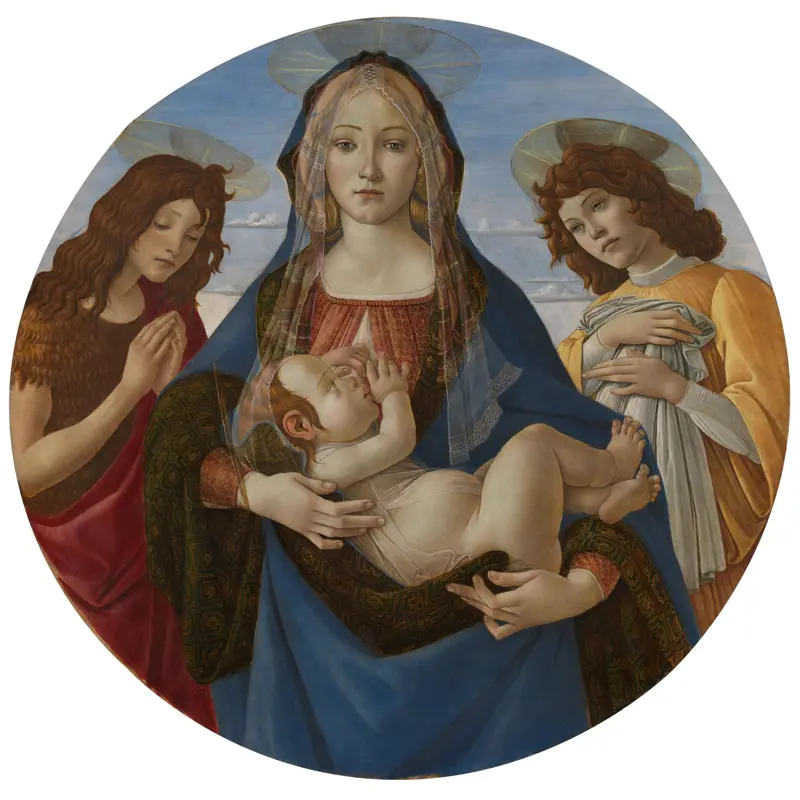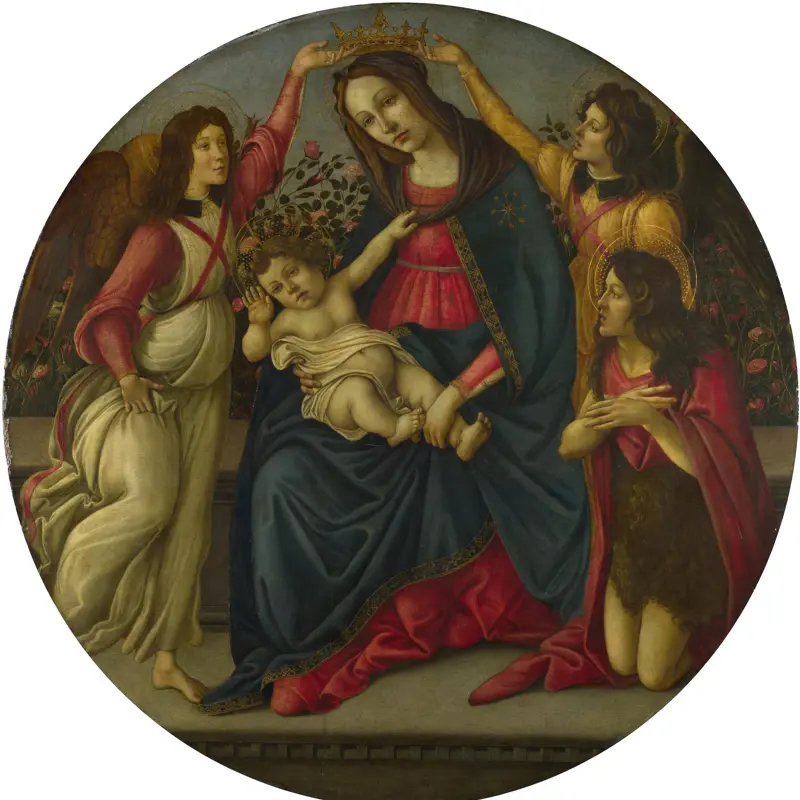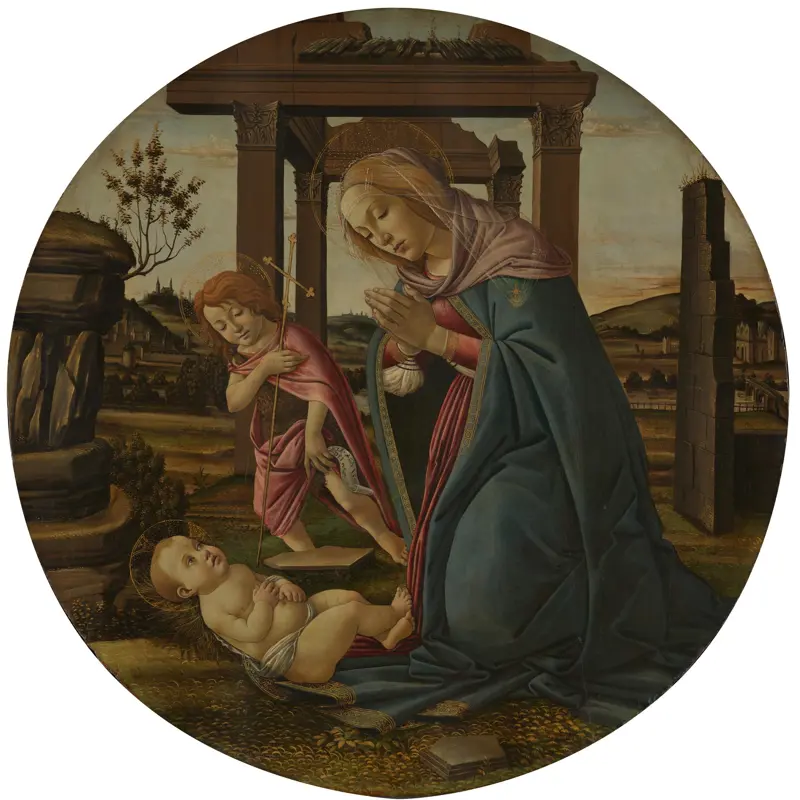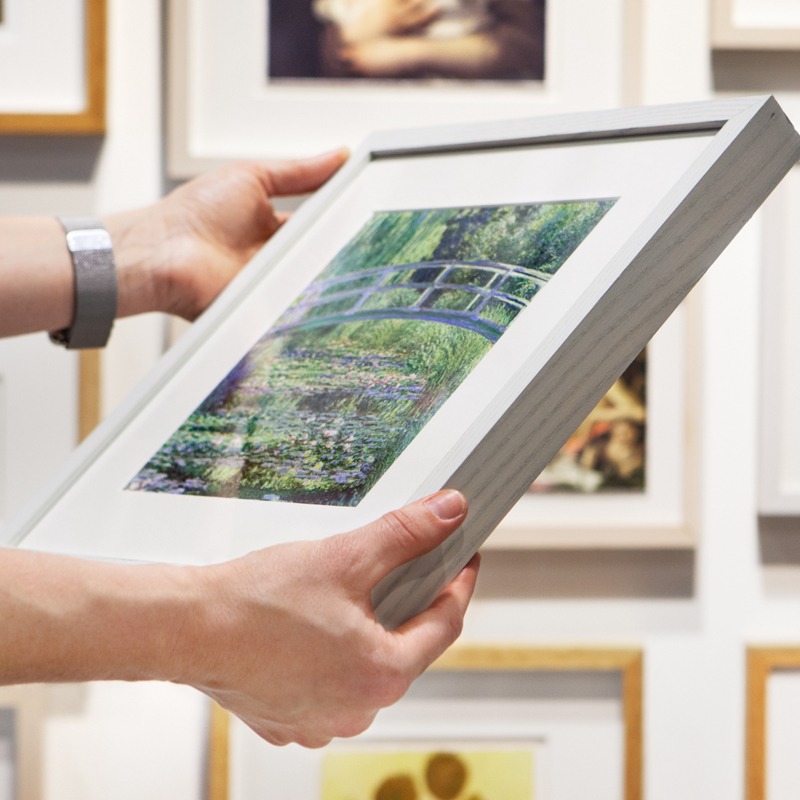Sandro Botticelli, 'Venus and Mars', about 1485
About the work
Overview
Venus, the goddess of love, looks over at her lover Mars. She is alert and dignified, while he – the god of war – is utterly lost in sleep. He doesn‘t even notice the chubby satyr (half child, half goat) blowing a conch shell in his ear.
This picture was probably ordered to celebrate a marriage, and the unusual shape suggests it was a spalliera, a panel set into the wall of a room. These panels were ordered to decorate the semi-public reception room known as a camera (a sort of bedchamber).
Botticelli’s picture is colourful and amusing but was also very fashionable – the cultures of Ancient Greece and Rome were admired by the elite in Renaissance Florence. Mars’ well-defined body refers deliberately to ancient sculptures. It might have had another function: women gazing upon beautiful male bodies were thought to be more likely to give birth to boys, essential for continuing the family line.
Audio description
Listen to an audio description of Botticelli’s 'Venus and Mars'
Transcript
This is a description of Venus and Mars, a painting by the Renaissance artist Sandro Botticelli dating to about 1485. It is a long, rectangular picture: painted with bright tempera and oil paints on a poplar wood panel. It is landscape orientated, about 70 centimetres tall and over 1 meter and 80 centimetres. The painting shows a young couple — both around 20 years old — lounging leisurely outdoors in a grassy clearing flanked by dense woodland and shrubbery. They face one another, their legs stretched out in front of them and very close. Although their reclining bodies fill the length of the canvas, there is enough space for four satyrs to crowd in, and tiptoe around them. These creatures belong to Greek mythology and resemble seven-year-old boys with cute potbellies. But also have furry legs, pointy ears and little, curved horns of goats. The young couple isn’t human either: on the left, Botticelli represented Venus, Goddess of Love, and on the right Mars, God of War. In the background, dark and light, brown and green brushstrokes, form trees and leaves on either side of the young couple. In the centre of the panel, the grassy landscape recedes further into the distance to soft green hills under a pale blue sky. On the right, faint shapes indicate a walled city beside a body of water. Venus and Mars command the space in the foreground. Venus lies on her side, her upper torso propped up on a pink cushion. It is a sunny,
summery day and she wears light clothing: a white pleated robe with slashed sleeves and a semi-transparent veil covering her body down to the ankle. Gold embroidered trim hems her garments outline her v-shaped neckline, round shoulders and breasts. Venus has long golden hair, swept back in a bun with elaborate plaits and loose ringlets framing her face. Her divine, pale, oval-shaped face and sharp chin. There is a gentle smile on her pale, rosy lips. Her brown eyes are alert, and her gaze is directed across at her companion. Opposite her, Mars is deep in slumber. His strong and fit body is sprawled out on a pink cloak, with one leg bent at the knee and the other stretched out behind the legs of Venus. The cloak is pulled taut as the toes of his outstretched foot get caught in its folds. His upper body is propped up on his empty grey metal breastplate which he is using as a pillow. His right arm lies in his lap and his left is bent, the fingers of this hand hanging above the hilt of his sword which is thrown on the grass, the blade hidden beneath the mantle. Crowned with a large mass of ginger-brown, curly hair, his head is thrown backwards with his thick neck fully extended. A satisfied expression on his face, his lips softly parted. He seems happily asleep and lost in his dreams. Mars is fully naked apart from a loose piece of white drapery that makes a small loincloth around his waist. His entire figure speaks of hulking strength. He might be a mighty warrior but he’s depicted as careless here: he
hasn’t been woken up by the satyr who has sneaked into his breastplate, leering cheekily with a hand on the sword’s hilt. Nor has Mars heeded the three satyrs, who tiptoe behind the young couple, moving from left to right, brandishing Mars’ lance. One cheeky satyr has also put on Mars grey metal helmet, while another, with puffed-out cheeks, blows into a large conch shell close to the Mars’ right ear. Next to his other ear, a swarm of wasps buzzes in and out of a hole in the tree behind him. We are held in suspense, moments before a cacophony of sound and action erupts: Mars could start at the loud honk, get stung by angry wasps and unleash his anger and fury.
You might think satyrs should have known better than to mess with Mars. But here, Botticelli presents a satire in painting, to make us laugh and ponder. We would miss two crucial details in fact if it weren’t for satyrs’ presence. First, the satyrs have sly, pernicious expressions on their round faces and rolled tongues in their open tiny mouths. They make fun of Mars’ lethargy, a reference to his exhaustion after physical intimacy. Some of the visual clues in the painting can also be interpreted as sexual innuendos: the long, erected lance; the sword's stiff blade; the deep opening in the conch shell; the large hole in the tree. The second detail is even more critical. The satyrs’ mythological nature is after all, the only visual signal that this well-off, ordinary couple of extraordinary beauty is actually divine and supernatural, revealing that they are indeed Mars and Venus.
Key facts
Details
- Full title
- Venus and Mars
- Artist
- Sandro Botticelli
- Artist dates
- about 1445 - 1510
- Date made
- about 1485
- Medium and support
- egg tempera and oil on wood
- Dimensions
- 69.2 × 173.4 cm
- Acquisition credit
- Bought, 1874
- Inventory number
- NG915
- Location
- Room 62
- Collection
- Main Collection
- Previous owners
- Frame
- 16th-century Italian Frame
Provenance
Additional information
Text extracted from the ‘Provenance’ section of the catalogue entry in Martin Davies, ‘National Gallery Catalogues: The Earlier Italian Schools’, London 1986; for further information, see the full catalogue entry.
Exhibition history
-
2010Close Examination: Fakes, Mistakes and DiscoveriesThe National Gallery (London)30 June 2010 - 12 September 2010
-
2024National TreasuresThe Fitzwilliam Museum10 May 2024 - 10 September 2024
Bibliography
-
1874J.W.C. Carr, 'The National Gallery', Art Journal, 1874, pp. 257ff
-
1874Christie, Manson & Woods, Catalogue of the Renowned Collection of Works of Art, Formed by that Distinguished Connoisseur, Alexander Barker, Esq., London, 6 June 1874 - 11 June 1874
-
1898J.P. Richter, Lectures on the National Gallery, London 1898
-
1906F. Wickhoff, 'Die Hochzeitsbilder Sandro Botticellis', Jahrbuch Preußischer Kulturbesitz, XXVII, 1906, pp. 198-207
-
1908H. Horne, Allessandro Filipepi, Commonly Called Sandro Botticelli, Painter of Florence, London 1908
-
1925Y. Yashiro, Sandro Botticelli, London 1925
-
1925E. Tietze-Conrat, 'Botticelli and the Antique', The Burlington Magazine, XLVII/270, 1925, pp. 124-9
-
1926W. Bode, Botticelli, Stuttgart 1926
-
1937E. Strong, 'Terra Mater or Italia?', Journal of Roman Studies, XXVII/1, 1937, pp. 114-26
-
1938J. Mesnil, Botticelli, Paris 1938
-
1939E. Panofsky, Studies in Iconolgy: Humanistic Themes in the Art of the Renaissance, New York 1939
-
1945E.H. Gombrich, 'Botticelli's Mythologies: A Study in the Neoplatonic Symbolism of His Circle', Journal of the Warburg and Courtauld Institutes, VIII, 1945, pp. 7-60
-
1946R.L. Douglas, Piero di Cosimo, Chicago 1946
-
1947P. Hendy, An Exhibition of Cleaned Pictures of 1947: (1936-1947), London 1947
-
1950E. Wind, 'The Eloquence of Symbols', The Burlington Magazine, XCII/573, 1950, pp. 349-50
-
1951Davies, Martin, National Gallery Catalogues: The Earlier Italian Schools, London 1951
-
1958R. Salvini, Tutta la pittura del Botticelli, Milan 1958
-
1960M. Levey, 'Botticelli and Nineteenth Century England', Journal of the Warburg and Courtauld Institutes, XXIII/3-4, 1960, pp. 291-306
-
1961M. Davies, The Earlier Italian Schools, 2nd edn, London 1961
-
1964J. Pope-Hennessy and R. Lightbown, Catalogue of Italian Sculpture in the Victoria and Albert Museum, London 1964
-
1966M. Meiss, 'Sleep in Venice: Ancient Myths and Renaissance Proclivities', Proceedings of the American Philosophical Society, CX/5, 1966, pp. 348-82
-
1967C. Bo and G. Mandel, L'opera completa del Botticelli, Milan 1967
-
1967E. Wind, Pagan Mysteries in the Renaissance, London 1967
-
1970W. Welliver, 'The Meaning and Purpose of Botticelli's Court of Venus and Mars and Venus', Art Quarterly, XXXIII, 1970, pp. 347-59
-
1971V. Juřen, '"Pan terrificus" de Politien', Bibliothèque d'humanisme et renaissance, XXXIII, 1971, pp. 641-5
-
1972E.H. Gombrich, Symbolic Images: Studies in the Art of the Renaissance, London 1972
-
1978R. Lightbown, Sandro Botticelli, London 1978
-
1978C. Gould, 'Sandro Botticelli: A Discriminating Assessment: Review of Lightbown', Apollo, CVIII, 1978
-
1984E. Callmann, 'Botticelli's Life of Saint Zenobius', Art Bulletin, LXVI/3, 1984, pp. 492-6
-
1984P. Holberton, 'Botticelli's "Hypnerotomachia" in the National Gallery: A Problem in the Use of Classical Sources in Renaissance Art', Illinois Classical Studies, IX/2, 1984, pp. 149-82
-
1985D. Sutton, 'Aspects of British Collecting, IV: The Age of Robert Browning', Apollo, CXXII/282, 1985, pp. 96-110
-
1986Davies, Martin, National Gallery Catalogues: The Earlier Italian Schools, revised edn, London 1986
-
1990C. Caneva, Botticelli: Catalogo completo dei dipinti, Florence 1990
-
1990G. Cornini, Botticelli, Florence 1990
-
1990C. Gizzi, Botticelli e Dante, Milan 1990
-
1991J. Dunkerton et al., Giotto to Dürer: Early Renaissance Painting in the National Gallery, New Haven 1991
-
1991D. Thiébaut, Botticelli, Paris 1991
-
1992R. Cocke, 'Botticelli's Primavera: The Myth of Medici Patronage', Apollo, CXXXVI, 1992, pp. 233-8
-
1992C. Olsen, 'Gross Expenditure: Botticelli's Nastagio degli Onesti Panels', Art History, XV/2, 1992, pp. 147-70
-
1993S. Fermor, Piero di Cosimo: Fiction, Invention and Fantasìa, London 1993
-
1994M. Calvesi, 'Venere e Marte di Botticelli: Una dolce sconfitta', Art e dossier, IX/86, 1994, pp. 26-9
-
1995U. Bischoff, Die 'Cassonebilder' des Piero di Cosimo: Fragen der Ikonographie, Frankfurt am Main 1995
-
1995P. Joannides, 'Late Botticelli: Archaism and Ideology', Arte Cristiana, LXXXIII/768, 1995, pp. 163-78
-
1995J.L. De Jong, 'Ovidian Fantasies: Pictorial Variations on the Story of Mars, Venus and Vulcan', in H. Walter (ed.), Die Rezeption der Metamorphosen des Ovid in der Neuzeit, Berlin 1995, pp. 161-71
-
1996M. Rohlmann, 'Botticellis "Primavera": Zu Anlaß, Adressat und Funktion von mythologischen Gemälden im florentiner Quattrocento', Artibus et historiae, XVII/33, 1996, pp. 97-132
-
1997B. Sewell, 'Why I Can't Climb into Bed with This Venus', Evening Standard, 1997
-
1998A. Grömling and T. Lingesleben, Alessandro Botticelli, 144/45-1510, Cologne 1998
-
1999P.L. Rubin and A. Wright, Renaissance Florence: The Art of the 1470s, (exh. cat. The National Gallery, 20 October 1999 - 19 January 2000), London 1999
-
2000P.L. Rubin, 'The Seductions of Antiquity', in C. Arscott and K. Scott (eds), Manifestations of Venus: Art and Sexuality, Manchester 2000, pp. 24-38, 177-83
-
2001
C. Baker and T. Henry, The National Gallery: Complete Illustrated Catalogue, London 2001
-
2001C. Dempsey, Inventing the Renaissance Putto, Chapel Hill, NC 2001
-
2001C.A. Luchinat, Botticelli: Allegorie mitologiche, Milan 2001
-
2002M. Autin Graz, Children in Painting, Milano 2002
-
2002I. Tognarini, L'identità e l'oblio. Simonetta, Semiramide e Sandro Botticelli, Milan 2002
-
2002R. Beach and K. Jakobsen, Modern British Art, (exh. cat. Offer Waterman & Co., 2002), London 2002
-
2003A. Chioetto and D. Comerlati (eds), Botticelli: From Lorenzo the Magnificent to Savonarola, Milan 2003
-
2003E. Guidoni, '"Venere e Marte" di Sandro Botticelli: Una nuova interpretazione', Studi giorgioneschi, VII, 2003, pp. 7-14
-
2004M. Ruvoldt, The Italian Renaissance Imagery of Inspiration: Metaphors of Sex, Sleep, and Dreams, Cambridge 2004
-
2004M. Calvesi, 'Venere effimera e Venere perenne, 1: Botticelli, Bronzino, Rubens, Piero di Cosimo, Lotto', Storia dell'arte, 2004, pp. 5-44
-
2004D. Arasse et al., Botticelli and Filippino: Passion and Grace in Fifteenth-Century Florentine Painting (exh. cat. Musée du Luxembourg, 1 October 2003 - 22 February 2004; Palazzo Strozzi, 10 March - 11 July 2004), Milan 2004
-
2005M. Belozerskaya, Luxury Arts of the Renaissance, Los Angeles 2005
-
2005A. Cecchi, Botticelli, Milan 2005
-
2006H. Körner, Botticelli, Cologne 2006
-
2008P. Barolsky, 'Iconography and the Depredation of Botticelli's Art', Source, XXVII/4, 2008
-
2008R.B. Ettle, 'The Venus Dilemma: Notes on Botticelli and Simonetta Cattaneo Vespucci', Source, XXVII/4, 2008, pp. 1-2
About this record
If you know more about this work or have spotted an error, please contact us. Please note that exhibition histories are listed from 2009 onwards. Bibliographies may not be complete; more comprehensive information is available in the National Gallery Library.

